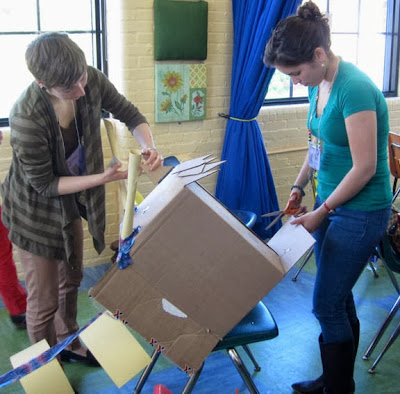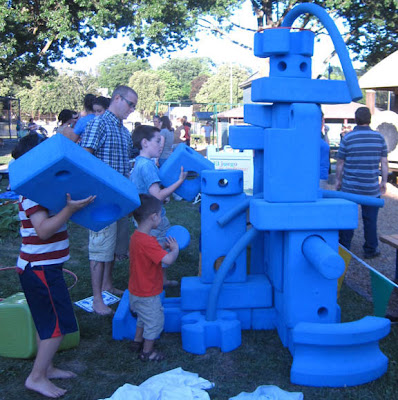As a researcher, how did you end up working in museums?
I was getting my PhD at Brandeis in cognitive neuroscience, looking at how people recognize faces and facial expressions in particular, and wanted to get outside of the lab, to apply what I was doing to something in the community. I found an internship that led to a fellowship at the Museum of Science in Boston. They had started a program working with scientists studying child development and needed someone to act as a liaison, to translate what they were doing for museum visitors and into exhibit materials. I did research in an educational psychology lab for a few years after that and when I saw this job – learning about how kids learn in the Museum – I thought it was perfect.
Describe your role in the project to make kids' learning visible.
 I’m trying to learn as much as possible about what and how kids learn
through play and how we can see it happening. I’ve read research on how
kids learn in formal and informal environments and how they think about
their own learning. I’ve talked with educators about how they see kids
learning and what it looks like. I’ve observed kids playing and talked
with parents about what they see their kids doing and what they think
they’re thinking about. Basically, my role is to connect the research
with the practice of what we’re doing in exhibits.
I’m trying to learn as much as possible about what and how kids learn
through play and how we can see it happening. I’ve read research on how
kids learn in formal and informal environments and how they think about
their own learning. I’ve talked with educators about how they see kids
learning and what it looks like. I’ve observed kids playing and talked
with parents about what they see their kids doing and what they think
they’re thinking about. Basically, my role is to connect the research
with the practice of what we’re doing in exhibits. Part of your work is in Dr. Sobel’s lab at Brown University. What does that involve?
I’m collecting data for a few different studies that are related to the same grant as the work that we’re doing at the Museum, about how kids think about learning as a concept. We’re asking kids what they think learning is and for examples of things they remember learning and how they learned them. Part of what we want to know is how kids’ awareness of their own thinking develops, which happens between the ages of 4 and 10 – kids start to reflect on what they’ve learned.
I have one Mind Lab shift per week at the Museum and recruit kids and parents for the studies. Back at the lab, I analyze and code the data and eventually we’ll publish articles with our findings.
How did you decide what to look for in your exhibit observations?
I looked at how scientists have quantified kids’ learning through play and the skills they observed and spoke with Museum educators about what it looks like when they see kids thinking really carefully. I came up with a list of 18 particular behaviors and we observed 80 different kids over the summer, making notes of what materials they were using, what they did, how they interacted with other people. Then we took the entire narrative of their time in the exhibit and tallied examples of each behavior.
The skills we were looking for are around kids noticing their own thinking because that’s something we want to encourage them to do more – if you notice and reflect on your thinking, you can have deeper learning experiences. We were looking at how they think ahead or plan, how they control what they’re doing in the moment or strategize, and then how they reflect on it afterwards.
What are you most looking forward to?
I’m excited to start testing out new materials in the exhibits and find different ways of showing what kids are thinking. I’m hoping we can come up with something really engaging that will help kids notice their own behavior a little more and encourage adults to do what I’ve been doing, to step back, watch and notice things they might not have noticed before – to observe almost scientifically. It’s interesting, when adults saw me noticing their kids’ play, they started to notice more as well.






















